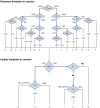Cardiopulmonary exercise testing in congenital heart disease: (contra)indications and interpretation
- PMID: 19949648
- PMCID: PMC2773030
- DOI: 10.1007/BF03086289
Cardiopulmonary exercise testing in congenital heart disease: (contra)indications and interpretation
Abstract
Cardiopulmonary exercise testing (CPET) in paediatric cardiology differs in many aspects from the tests performed in adult cardiology. Children's cardiovascular responses during exercise testing present different characteristics, particularly oxygen uptake, heart rate and blood pressure response, which are essential in interpreting haemodynamic data. Diseases that are associated with myocardial ischaemia are rare in children. The main indications for CPET in children are evaluation of exercise capacity and the identification of exercise-induced arrhythmias. In this article we will review the main indications for CPET in children with congenital heart disease, the contraindications for exercise testing and the indications for terminating an exercise test. Moreover, we will address the interpretation of gas exchange data from CPET in children with congenital heart disease. (Neth Heart J 2009;17:385-92.).
Keywords: children; ergometry; exercise physiology; exercise test; oxygen uptake.
Figures

Similar articles
-
Cardiopulmonary exercise testing in congenital heart disease: equipment and test protocols.Neth Heart J. 2009 Sep;17(9):339-44. doi: 10.1007/BF03086280. Neth Heart J. 2009. PMID: 19949476 Free PMC article.
-
Exercise testing in pediatric cardiology.Rev Port Cardiol. 2005 Jun;24(6):885-95. Rev Port Cardiol. 2005. PMID: 16121679 Review. English, Portuguese.
-
The role of exercise testing in pediatric cardiology.Arch Cardiovasc Dis. 2014 May;107(5):319-27. doi: 10.1016/j.acvd.2014.04.004. Epub 2014 May 17. Arch Cardiovasc Dis. 2014. PMID: 24841496 Review.
-
[Cardiopulmonary Exercise Testing-Step by Step].Dtsch Med Wochenschr. 2019 Jan;144(1):39-45. doi: 10.1055/a-0600-9233. Epub 2019 Jan 2. Dtsch Med Wochenschr. 2019. PMID: 30602186 Review. German.
-
Cardiopulmonary exercise testing and its application.Postgrad Med J. 2007 Nov;83(985):675-82. doi: 10.1136/hrt.2007.121558. Postgrad Med J. 2007. PMID: 17989266 Free PMC article. Review.
Cited by
-
Clinical Evaluation of Exercise Capacity in Adults with Systemic Right Ventricle.Tex Heart Inst J. 2019 Feb 1;46(1):14-20. doi: 10.14503/THIJ-17-6408. eCollection 2019 Feb. Tex Heart Inst J. 2019. PMID: 30833832 Free PMC article.
-
Characterizing the Use of Exercise Testing in Repaired Tetralogy of Fallot Patients: A Multi-Institutional Survey.Res Sq [Preprint]. 2023 Jul 7:rs.3.rs-3131080. doi: 10.21203/rs.3.rs-3131080/v1. Res Sq. 2023. Update in: Pediatr Cardiol. 2023 Dec;44(8):1821-1830. doi: 10.1007/s00246-023-03269-9. PMID: 37461658 Free PMC article. Updated. Preprint.
-
Brazilian Guideline for Exercise Testing in Children and Adolescents - 2024.Arq Bras Cardiol. 2024 Sep 16;121(8):e20240525. doi: 10.36660/abc.20240525. Arq Bras Cardiol. 2024. PMID: 39292116 Free PMC article. English, Portuguese.
-
Why exercise capacity does not improve after pulmonary valve replacement.Pediatr Cardiol. 2014 Dec;35(8):1395-402. doi: 10.1007/s00246-014-0942-2. Epub 2014 Jul 3. Pediatr Cardiol. 2014. PMID: 24990282
-
Predictive Role of Atrial Strain, Aortic Stiffness, and Muscle-Related Factors for Maximal and Submaximal Exercise Capacity in Fontan Patients.Pediatr Cardiol. 2024 Oct 29. doi: 10.1007/s00246-024-03687-3. Online ahead of print. Pediatr Cardiol. 2024. PMID: 39470752
References
-
- Connuck DM. The role of exercise stress testing in pediatric patients with heart disease. Pediatr Cardiol. 2005;20:45–52.
-
- Bar-Or O. Pathophysiological factors which limit the exercise capacity of the sick child. Med Sci Sports Exerc. 1986;18:276–82. - PubMed
-
- Lunt D, Briffa T, Briffa NK, Ramsay J. Physical activity levels of adolescents with congenital heart disease. Aust J Physiother. 2003; 49:43–50. - PubMed
-
- Rich MW. Heart failure disease management: a critical review. J Card Fail. 1999;5:64–75. - PubMed
-
- Alpert BS, Verrill DE, Flood NL, Boineau JP, Strong WB. Complications of ergometer exercise in children. Pediatr Cardiol. 1983; 4:91–6. - PubMed
LinkOut - more resources
Full Text Sources
